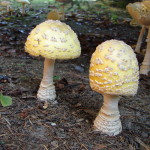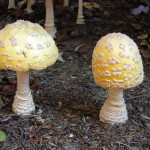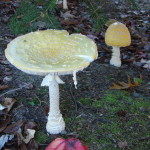The American Eastern Yellow Fly Agaric mushrooms (Amanita muscaria var. guessowii) appear during periods of high humidity in our conifer forests, often growing under white pine or eastern hemlock trees.
It’s characterized by white gills and stem, a white spore print, warts on the cap which easily wash or rub off, a membranous partial veil that leaves a distinct membranous mid-stem ring and remains of the universal veil seen as three small rings of tissue just at the enlarged stem base. The yellow/orange color, which often has a metallic shine, stands out among leaf litter on the forest floor.
The red Fly Agaric is the typical colorful toadstool seen in children’s books. All varieties are poisonous and some have hallucinogenic properties. The North American variety is not a hallucinogen but is poisonous so do not touch or eat it.
The common name “Fly Agaric” refers to the fact that in the Middle Ages Europeans learned that the mushroom crushed in a saucer of milk would attract flies that would become stupefied and drown. In some parts of the world, Amanita muscaria is still used as an insecticide.
Photos of the Yellow Fly Agaric Mushroom
-
American Eastern Yellow Fly Agaric / Amanita muscaria var. guessowii
-
American Eastern Yellow Fly Agaric / Amanita muscaria var. guessowii
-
American Eastern Yellow Fly Agaric / Amanita muscaria var. guessowii
-
American Eastern Yellow Fly Agaric / Amanita muscaria var. guessowii
-
American Eastern Yellow Fly Agaric / Amanita muscaria var. guessowii
-
American Eastern Yellow Fly Agaric / Amanita muscaria var. guessowii
-
American Eastern Yellow Fly Agaric / Amanita muscaria var. guessowii
-
American Eastern Yellow Fly Agaric / Amanita muscaria var. guessowii
-
American Eastern Yellow Fly Agaric / Amanita muscaria var. guessowii
If you like mushrooms, you might enjoy my Pinterest board, “Les Champignons.”










TrackBack URL
https://www.karenfurst.com/blog/amanita-muscaria-var-guessowii-american-eastern-yellow-fly-agaric-mushroom/trackback/